The following information is summarized from the Northern Colorado Plateau Network monitoring plan, published in 2004. Some details may have changed.
Park History and Purpose
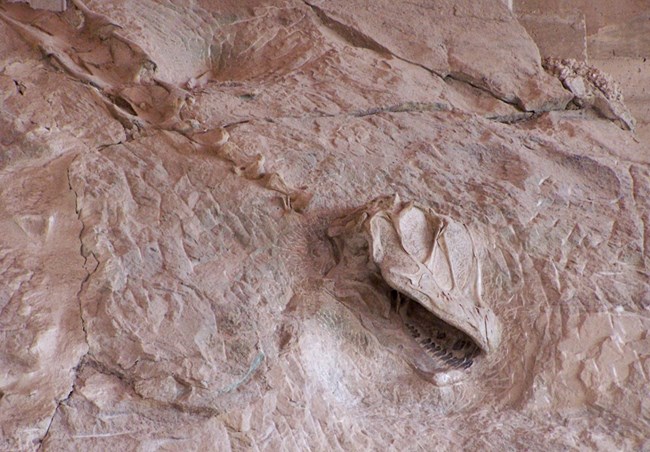
NPS
Dinosaur National Monument was established by Presidential Proclamation 1313 on October 4, 1915 (39 Stat. 1752), as an 80-acre monument to preserve the outstanding fossil resources at the dinosaur quarry north of Jensen, Utah. In 1938, Presidential Proclamation 2290 enlarged the monument to 82,510 hectares (203,885 acres) (53 Stat. 2454). This proclamation cited the Act of August 25, 1916, that established the National Park Service (16 USC 1a-7), thereby identifying Dinosaur National Monument as an area to be administered for purposes of preservation of natural resources and public use. A major focus of the expansion was protection of river corridors and adjacent viewsheds for the major canyons of the Green and Yampa rivers.
On September 8, 1960, Congress passed Public Law 86-729, 74 Stat. 857, which enlarged the monument to 85,447 hectares (211,141.69 acres). Public Law 86-729 also established procedures directed toward the eventual elimination of grazing from the monument.Due to its complex natural and cultural resources, a number of other federal laws and executive orders influence both short-term and long-term resource management decisions in Dinosaur National Monument. Among them are the National Park Service Organic Act (including the Redwood Amendment), National Environmental Policy Act, Endangered Species Act, Fish and Wildlife Coordination Act, Migratory Bird Treaty Act, Clean Water Act, Executive Order 11988 – Floodplain Management, Executive Order 11990 – Protection of Wetlands, and Executive Order 13112 – Invasive Species.
General Description
Dinosaur National Monument includes canyons of the lower Yampa River and upper Green River below Browns Park. Using the confluence of the Green and Yampa rivers in Echo Park as a central point, the monument extends upstream on the Yampa some 46 river miles, upstream on the Green about 20 river miles, and downstream on the Green another 25 river miles. The land base extends as far as five miles laterally from the river courses. The rivers flow through deep canyons with high-velocity, high-gradient stream reaches interspersed with more open parks with lower stream gradients.
The monument also includes dinosaur fossils of international renown, primarily in the vicinity of the Dinosaur Quarry and its Jurassic fossils. In addition to the Quarry, some 450 other dinosaur fossil sites are exposed on the surface. Fossil materials range from Jurassic to Quaternary and include plant, reptilian, and mammal remains. The monument also displays the widest range of geologic stratigraphic history on the Colorado Plateau. These features make the monument a preferred site for paleontological and geological research.
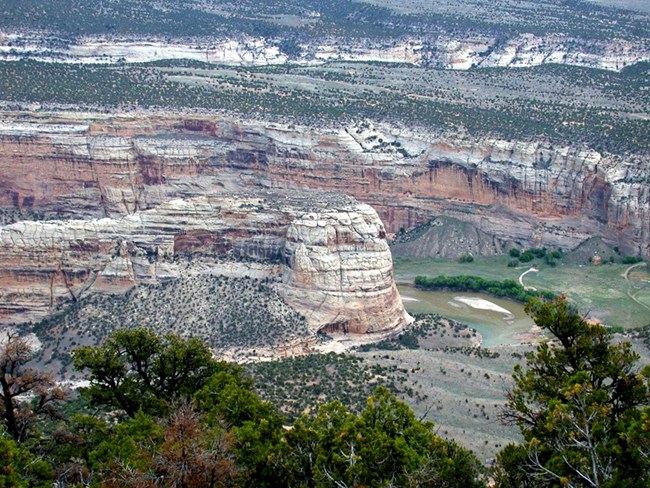
NPS
Biotic diversity is high due to Dinosaur’s location at the convergence of five physiographic provinces: the Colorado Plateau, Wyoming Basin, Great Basin, and Central and Southern Rocky Mountains. Plant communities include montane coniferous forest, pinyon-juniper woodland, mixed mountain shrub, sagebrush-grassland, cold desert shrubland, barrens, and low-elevation riparian woodland. Altitudinal juxtapositions are not uncommon.
Physiographic location, topography, folding and faulting of geologic substrates, and the presence of large desert rivers combine to produce an unusually diverse biota.
Significant endemism is evident in native fish populations (only eight species) and vascular flora (15 Uinta Basin endemics among the over 40 rare species). The monument includes the upper and middle Green River and the lower Yampa River. The Yampa River is the only large tributary in the Colorado River system that remains unregulated by a major mainstream impoundment and, as such, is singularly important in sustaining endangered fish in the Upper Colorado River Basin.
About 40 non-native fish and nearly 70 non-native plant species now occupy monument lands and waters. Some of these (e.g., channel catfish, northern pike, tamarisk, perennial pepperweed, Russian knapweed, spotted knapweed, and leafy spurge) are of particular concern because of their adverse impacts on native flora and fauna.
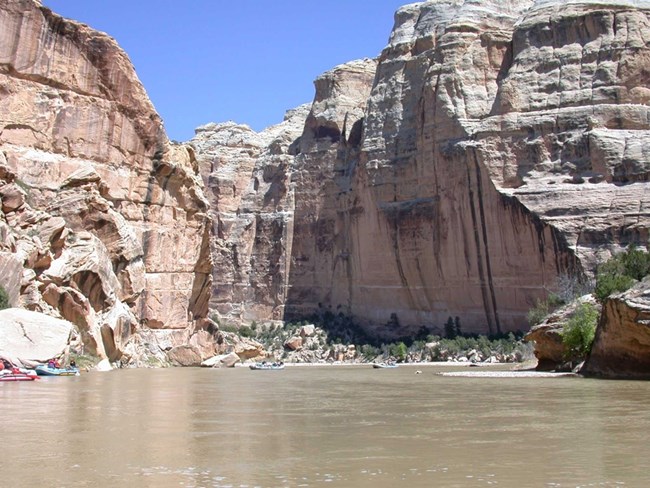
NPS
Location
Northwestern Colorado and northeastern Utah, on the easternmost extension of the Uinta Mountain anticline at the northern edge of the Colorado Plateau. The monument is shaped somewhat like an inverted T. At its widest and longest dimensions, it is 35 kilometers (22 miles) north to south and 71 kilometers (44 miles) east to west. Portions are approximately 32 highway kilometers (20 miles) east of Vernal, Utah; 80 kilometers (50 miles) west of Craig, Colorado; and about 193 kilometers (120 miles) north of Grand Junction, Colorado.
Elevation
Elevations range from under 1,448 meters (4,750 feet) near the Quarry to over 2,743 meters (9,000 feet) at Zenobia Peak. Annual precipitation ranges from under 280 millimeters (11 inches) at low elevations to nearly 508 millimeters (20 inches) at the highest elevations.
Size
85,097 hectares (210,278 acres)
Plants and Animals
Visitors may encounter a wide range of native and nonnative plant and animal species throughout the site.
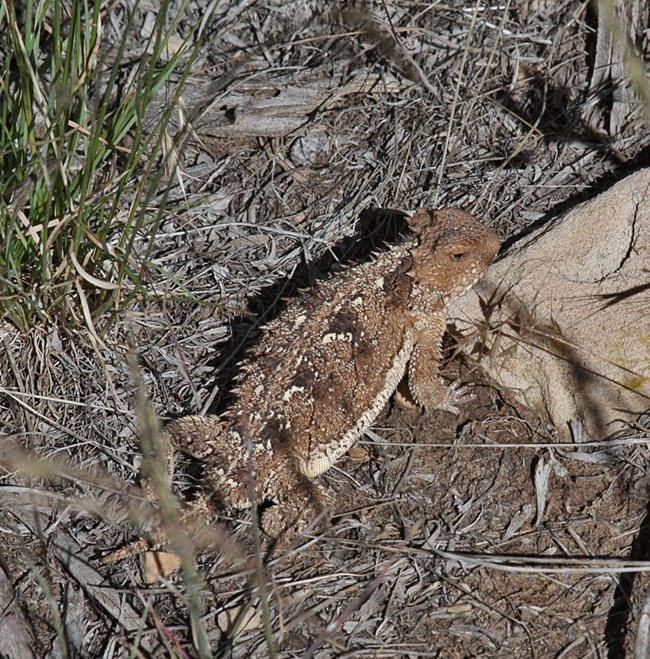
NPS
Flora
Great diversity of geologic substrates combines with extreme topographic variation within the monument to produce plant communities that are nearly all ecotonal (transitional) to some degree. A diverse landscape supports plant communities reminiscent of several ecoregional provinces described by Bailey, including Intermountain Semi-Desert and Desert, Utah Mountains Semi-Desert–Coniferous Forest, Southern Rocky Mountain Steppe–Open Woodland–Coniferous Forest, and Colorado Plateau Semi-Desert. Most vegetation falls within montane or submontane/cold-temperate lowland zones (Colorado Plateau Province). Classification of plant communities is problematic because of variation within the physical environment.
More than 700 plant species have been documented. Dinosaur’s cold desert flora is particularly rich in localized endemic species. Hanging-garden communities along the Yampa and Green rivers and their tributaries exhibit a close relationship with those found lower in the Colorado River drainage. Invasive non-native plants threaten native plant communities in a variety of habitats, especially within the river corridors. Prescribed fire has been used extensively in an effort to restore native grassland communities degraded by livestock grazing and fire suppression.
Fauna
The monument is home to over 270 bird species, 14 reptile species, 5 amphibian species, about 40 fish species, and nearly 70 mammalian species. Large ungulates include elk, mule deer, bighorn sheep, and moose; bison have been extirpated. Large mammalian predators include mountain lion, bobcat, coyote, fox, and black bear; grizzly bear and wolf have been extirpated. Nearly the entire Colorado bat fauna is represented in Dinosaur (approximately 16 species). Raptors include peregrine and other falcons, Mexican spotted owl, bald and golden eagles, osprey, accipiters, harriers, hawks, and other owls. Non-native species are a notable problem only within the fish component, where multiple non-native species prey on or compete with various life stages of endangered fishes.
Unique Features and Species of Special Concern
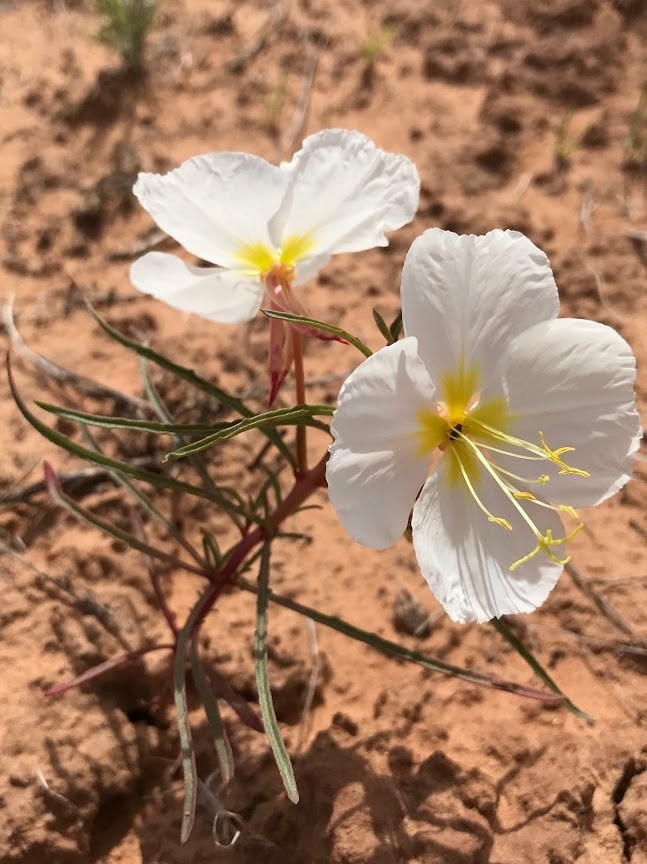
NPS/Kiki Fahey
Vegetation Communities
Plant communities of special concern include hanging gardens, riparian woodlands and related floodplain habitats, mountain mahogany tall shrublands, limestone barrens, and wetlands associated with tributary streams or upland springs and seeps. Fremont cottonwood demonstrates a unique recruitment strategy along the Green and Yampa rivers. Dinosaur represents a unique and important ecological research opportunity in that both the Yampa (unregulated) and the Green (regulated) rivers drain similarly sized watersheds and have their confluence in the park. Comparisons between the two river systems have produced a great deal of useful ecological information. Several rare plants are associated with mesic habitats, including Ute ladies’-tresses orchid, alcove bog orchid (Habenaria zothecina), alcove death camas (Zigadenus vaginatus), and narrowleaf evening primrose (Oenothera spp.).
Plants
The monument provides habitat for approximately 40 rare plant species. Only one is listed as threatened: Ute ladies’-tresses orchid (Spiranthes diluvialis). Approximately 15 species are endemic to the Uinta Basin.
The Green River District (Utah portion) of Dinosaur National Monument is an extremely important center of plant endemism in the context of the Uinta Basin. Erosion of the Split Mountain Anticline exposed numerous geologic formations in a relatively small area. The result is pronounced partitioning of plant habitats and a concomitant concentration of endemic plant species. Type localities for at least nine endemic plant species occur within or very near the Green River District. Though less frequent in the Yampa River District, rare plants occur throughout the monument’s Colorado portion.
Animals
Listed species include the Colorado pikeminnow, humpback chub, razorback sucker, bonytail, Mexican spotted owl, and bald eagle. Species proposed for protection by the Endangered Species Act include spotted bat, roundtail chub, flannelmouth sucker, sage-grouse, northern goshawk, and ferruginous hawk. Black-footed ferrets have been reintroduced in the local region; it is not beyond possibility that some individuals could eventually occupy the park. Peregrine falcons, though recently delisted, remain of special concern and the focus of long-term monitoring. Also of management concern due to rarity, sensitivity, and/or potential management problems are bighorn sheep, elk, and bats.
Resource Management Concerns
Livestock Grazing
There remain 11 grazing allotments on approximately 32,375 hectares (80,000 acres), with a total maximum grazing preference of about 2,300 AUMs. Most grazing remaining is appurtenant to inholdings and will therefore not be terminated until inholdings are purchased. Grazing pressure varies by allotment, with some livestock use having minimal impacts and some allotments exhibiting significant adverse impacts. Such adverse impacts include shifts in plant community composition toward non-native species, introduction and spread of invasive non-native plants, competition for resources (forage, water, cover) with native ungulates, displacement of native ungulates, potential for disease transmission (particularly with bighorn sheep), destruction of rare plants, damage to riparian resources, damage to upland water sources, damage to cultural resources, and conflicts with recreational uses.
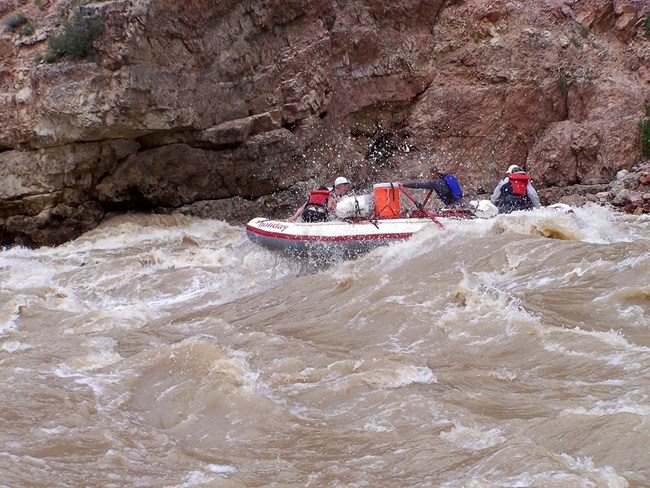
NPS
Recreation Use
Dinosaur hosts hundreds of thousands of visitors annually; the vast majority visits only the Quarry. However, nearly half of total visitor hours are associated with river use. Although the monument’s river management plan limits whitewater river use (number of launches, group size), impacts of human use in the river canyons appear to be increasing. Among other things, social trails in and near campsites are proliferating; monitoring indicates an increase in bare ground area and in occurrence of human fecal matter. Recreational use impacts are increasing in side canyons and other areas adjacent to the river because of increasing use from travel originating both within and outside the river corridor. Mountain bike use, though nominally confined to existing roads, is increasing, along with subsequent adverse impacts (e.g., to microbiotic soils).
Land Use Impacts
Only very limited agricultural cultivation occurs on private lands within the monument. Activities on adjacent federal and private lands have potential to adversely impact resources and resource values. Various land uses, existing and proposed water depletions, and operation of Flaming Gorge Dam significantly and adversely impact resources. There has been an apparent significant rise in pH on the Yampa River—to the point of potential fish kills. Ongoing research is designed to determine if the pH rise is real or an artifact of sampling methodologies. If the increase is real, then research will attempt to identify sources of change.
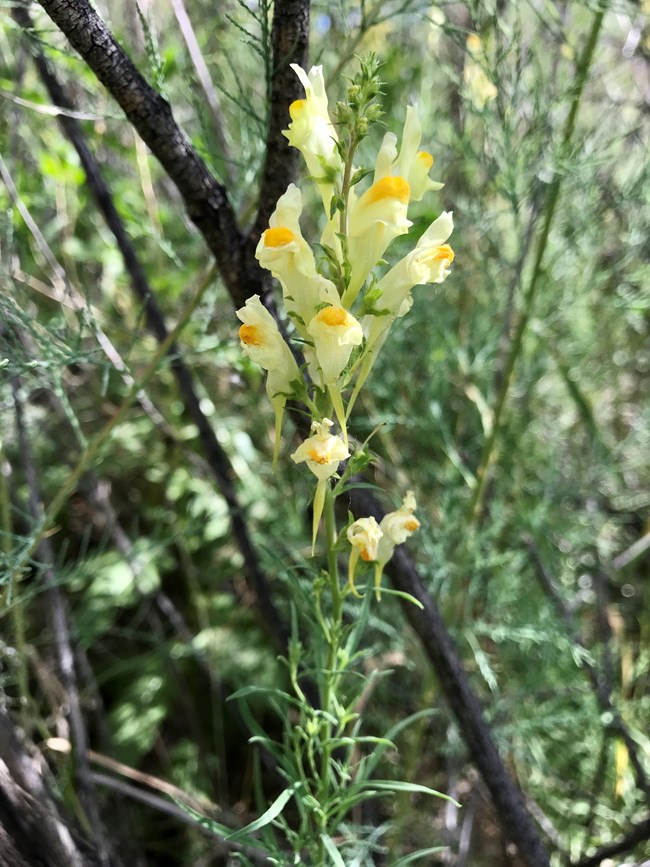
NPS/Amy Washuta
Endemic and Special Concern Plant Species
The Green River District contains a number of important developed facilities (e.g., campgrounds, boat ramp, picnic area, fossil quarry and visitor center, housing area, maintenance yard, fire cache, hiking trails). The frequency and density of sensitive plants in the Green River District require frequent clearances for surface-disturbing maintenance and construction activities. Inadequate map and inventory information make clearance time-consuming, resulting in occasional work delays and/or substandard clearance work.
To date, no evidence of plant poaching or intentional damage to sensitive plant species has been documented. Reports of this activity at nearby Capitol Reef National Park indicate the possibility for exploitation by collectors. Another potential threat arises from road improvements that may lead to increased backcountry use. Known threats to rare plants include unauthorized off-road vehicle use, recreational social trailing, increased use by horses associated with commercial trail rides, changes in livestock grazing-use patterns, and invasive-species encroachment.
Invasive Exotic Plant Species
Sixty-six non-native plant species have been identified in the monument. Fourteen are invasive; these include common burdock, cheatgrass, hoary cress, musk, bull, and Canada thistle; spotted and Russian knapweed; Russian olive; leafy spurge; perennial pepperweed; Dalmatian toadflax; yellow sweet clover; and tamarisk. Flaming Gorge Dam operations, livestock grazing, and external vectors have contributed to invasive plant establishment and spread. National Park Service fire-management operations, new construction, roadside vegetation management, and facility-maintenance operations have also contributed. Appropriate weed management and native plant restoration have lagged significantly behind identified needs.
Last updated: June 27, 2025
